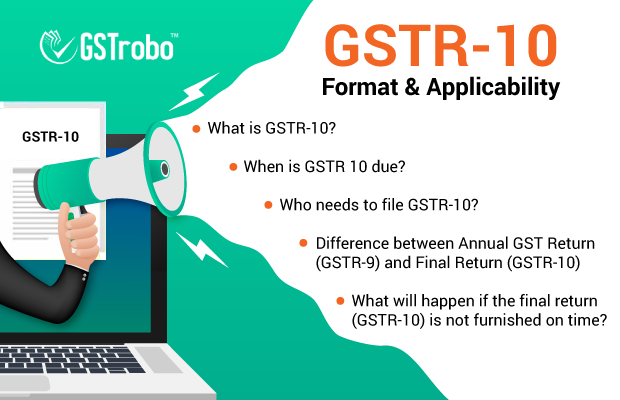GSTR-10: Format and Applicability
GSTR-10 is a final return that needs to be filed by all the registered taxable persons whose GST registration is either canceled or surrendered. In this blog, we will discuss GSTR-10 in detail.

What is GSTR-10?
Any registered taxable person whose GST registration is either canceled or surrendered needs to furnish a final return also known as GSTR-10.
When is GSTR-10 Due?
GSTR-10 should be filed within 90 days from the date of cancellation or date of cancellation request whichever is later. For example, if the date of cancellation is 1st January 2022, so in this case, the final return (GSTR-10) needs to be filed by 31st March 2022.
Who Needs to File GSTR-10?
GSTR-10 needs to be filed by those taxpayers whose GST registration has been canceled or surrendered. Every person registered under GST need not record the final return.
Difference between Annual GST Return (GSTR-9) and Final Return (GSTR-10)
| S.No. | Parameter | Annual GST Return (GSTR-9) | Final Return (GSTR-10) |
| 1. | Who needs to file it? | Every Normal taxable person registered under GST. | Any registered taxable person who has been canceled or surrendered. |
| 2. | What is the filing frequency? | Once in a year. | 90 days from the date of cancellation or request of cancellation whichever is later. |
Penalty for Not Filing Final Return (GSTR-10) on Time?
If the GSTR 10 isn’t furnished within the due date, a notification will be given to such a registered taxable person. The individual will be given 15 days’ for recording the return with all the documents required.
In the event that the individual neglects to record the return, the assessment officer will pass the final request for the cancellation with the measure of tax payable alongside interest/punishment.
Subtleties to be Provided in GSTR-10
GSTR 10 has an aggregate of 10 segments. Following are the segments that will get auto-populated:
- GSTIN
- Legal Name
- Business Name
- Address
The following are the segments under which data needs to be furnished:
5. Application Reference Number: ARN should be furnished in the event that the application for cancellation has been endorsed by the authorities. In such cases, ARN will be imparted to the taxpayer at the time of passing the cancellation request.
6. Effective Date of Surrender/Cancellation: Here you need to make reference to the date of cancellation of GST registration as contained in the request.
7. Whether cancellation request has been passed: Taxpayer needs to indicate whether the return is being filed based on the cancellation request or voluntarily.
8. If Yes, Unique ID of Cancellation request: Unique ID will be given by authorities at the time of passing cancellation request.
9. Date of Cancellation Order: This column will contain the date on which the authorities have passed the GST registration cancellation request.
10. Closing Stock: The citizen needs to furnish the details about the closing stock held at the time of shutting down the business. Any credit lying in such stock should be paid alongside this return.
10A. Amount of Tax Payable on Closing Stock: The amount of tax payable will get auto-processed under this head based on the basis of declaration made in the above segment 10.
When all the specifics are furnished accurately, the taxpayer needs to sign the same carefully either through a DSC or AADHAAR based verification to verify the final return (GSTR-10).
How GSTrobo® can Help You?
GSTrobo® (a division of Binary Semantics) is an authorized GSP and enlisted SDA with GSTN. GSTrobo® has an integrated and collaborative approach between E-Invoice, GST compliance, E-Way bill & telematics that has helped many organizations go digital completely with ease & compliance. The industry leaders are relying on the ease and simplicity of GST compliances for requirements ranging from Cloud-based solutions to Integrated Distributed Computing Solution utilizing powerful APIs and connectors from GSTrobo®.
